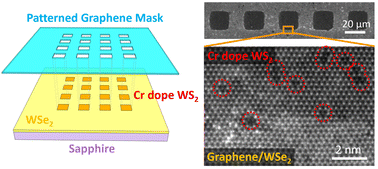Patterning and doping of transition metals in tungsten dichalcogenides†
Abstract
Substitutional transition metal doping in two-dimensional (2D) layered dichalcogenides is of fundamental importance in manipulating their electrical, excitonic, magnetic, and catalytic properties through the variation of the d-electron population. Yet, most doping strategies are spatially global, with dopants embedded concurrently during the synthesis. Here, we report an area-selective doping scheme for W-based dichalcogenide single layers, in which pre-patterned graphene is used as a reaction mask in the high-temperature substitution of the W sublattice. The chemical inertness of the thin graphene layer can effectively differentiate the spatial doping reaction, allowing for local manipulation of the host 2D materials. Using graphene as a mask is also beneficial in the sense that it also acts as an insertion layer between the contact metal and the doped channel, capable of depinning the Fermi level for low contact resistivity. Tracing doping by means of chalcogen labelling, deliberate Cr embedment is found to become energetically favorable in the presence of chalcogen deficiency, assisting the substitution of the W sublattice in the devised chemical vapor doping scheme. Atomic characterization using scanning transmission electron microscopy (STEM) shows that the dopant concentration is controllable and varies linearly with the reaction time in the current doping approach. Using the same method, other transition metal atoms such as Mo, V, and Fe can also be doped in the patterned area.



 Please wait while we load your content...
Please wait while we load your content...